Mudra
A mudra (/muˈdrɑː/ (![]()
In hatha yoga, mudras are used in conjunction with pranayama (yogic breathing exercises), generally while in a seated posture, to stimulate different parts of the body involved with breathing and to affect the flow of prana, bindu (male psycho-sexual energy), boddhicitta, amrita or consciousness in the body. Unlike older tantric mudras, hatha yogic mudras are generally internal actions, involving the pelvic floor, diaphragm, throat, eyes, tongue, anus, genitals, abdomen, and other parts of the body. Examples are Mula Bandha, Mahamudra (Hatha Yoga), Viparita Karani, Khecarī mudrā, and shambavi. These expanded in number from 3 in the Amritasiddhi, to 25 in the Gheranda Samhita, with a classical set of ten arising in the Hatha Yoga Pradipika.
Nomenclature
The Chinese translation is yin (Chinese: 印; pinyin: yìn) or yinxiang (Chinese: 印相; pinyin: yìnxiàng). The Japanese and Korean pronunciation is "in".
Iconography
Mudra is used in the iconography of Hindu and Buddhist art of the Indian subcontinent and described in the scriptures, such as Nātyaśāstra, which lists 24 asaṁyuta ("separated", meaning "one-hand") and 13 saṁyuta ("joined", meaning "two-hand") mudras. Mudra positions are usually formed by both the hand and the fingers. Along with āsanas ("seated postures"), they are employed statically in the meditation and dynamically in the Nāṭya practice of Hinduism.
Hindu and Buddhist iconography share some mudras. In some regions, for example in Laos and Thailand, these are distinct but share related iconographic conventions.
According to Jamgotn Kongtrul in his commentary on the Hevajra Tantra, the ornaments of wrathful deities and witches made of human bones (Skt: aṣṭhimudrā; Wylie: rus pa'i rgyanl phyag rgya ) are also known as mudra "seals".[3]
Indian classical dance
In Indian classical dance, the term "Hasta Mudra" is used. The Natya Shastra describes 24 mudras, while the Abhinaya Darpana of Nandikeshvara gives 28.[4] In all their forms of Indian classical dance, the mudras are similar, though the names and uses vary. There are 28 (or 32) root mudras in Bharatanatyam, 24 in Kathakali and 20 in Odissi. These root mudras are combined in different ways, like one hand, two hands, arm movements, body and facial expressions. In Kathakali, which has the greatest number of combinations, the vocabulary adds up to c. 900. Sanyukta mudras use both hands and asanyukta mudras use one hand.[5]
Yogic mudras
The classical sources for the mudras in yoga are the Gheranda Samhita and the Hatha Yoga Pradipika.[6] The Hatha Yoga Pradipika states the importance of mudras in yoga practice:
Therefore the goddess sleeping at the entrance of Brahma's door should be constantly aroused with all effort, by performing mudra thoroughly.
In the 20th and 21st centuries, the yoga teacher Satyananda Saraswati, founder of the Bihar School of Yoga, continued to emphasize the importance of mudras in his instructional text Asana, Pranayama, Mudrā, Bandha.[6]
Basic mudra: Chin Mudrā
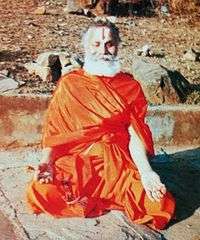
The thumb and forefinger on each of the hands are joined, forming a zero. The rest of the fingers are extended. The hands are placed palms-up on the thighs or knees while sitting in vajrasana for meditation, or palm-down for pranayama. This mudrā supposedly activates the diaphragm, making for deep "stomach-breathing" as the diaphragm pushes out the internal organs when it descends towards the pelvis on inhalation. Slow breathing in a 5-2-4-2 mentally counted rhythm (counting to 5 during the exhalation, to 2 while holding the breath, and to 4 on the inhalation) causes prana flow in the pelvis and in the legs.
Basic mudra: Chinmaya Mudrā
The thumb and forefinger are the same as in Chin Mudrā. The rest of the fingers are folded into a fist. The non-folded part of the forefinger and the middle finger should still be touching. As in Chin Mudrā, the hands are placed palms-up on the thighs while sitting in Vajrasana for meditation, or palm-down for pranayama. This mudra supposedly activates the ribs, making them expand sideways on inhalation. Slow breathing in a 5-2-4-2 counted rhythm (counting to 5 during the exhalation, to 2 while holding the breath, and to 4 on the inhalation) causes prana flow in the torso and in the throat.
Basic mudra: Adi Mudrā
The thumb is folded into the palm, touching the base of the small finger. The rest of the fingers are folded over the thumb, to create a fist. The hands are placed palms down on the thighs while sitting in Vajrasana. This mudra supposedly activates the pectoral muscles, making the chest expand forward on inhalation. Slow breathing in a 5-2-4-2 counted rhythm (counting to 5 during the exhalation, to 2 while holding the breath, and to 4 on the inhalation) makes prana flow in the throat and in the head.
Basic compact mudra: Brahma Mudrā
The hands are as in Adi Mudrā, but the palms face upwards and are located at the level of the navel, with the left and right knuckles and first finger joints touching. This is done while sitting in Vajrasana. Breathing becomes full: in inhalation, the diaphragm descends, the ribs then expand, and then the pectoral muscles move forward. Exhalation works in the same order, which creates a "wave" or ripple effect.
Advanced compact mudra: Prana Mudrā
A complicated mudra combining hand gestures, synchronized movement from gesture to gesture within the breath cycle, and meditation. The mudrā is practiced sitting in Siddhasana. Even a single breath cycle of this mudra can significantly stimulate the body. It is described in the book, Theories of the Chakras, by Hiroshi Motoyama.
Common Buddhist mudrās
Abhaya Mudrā
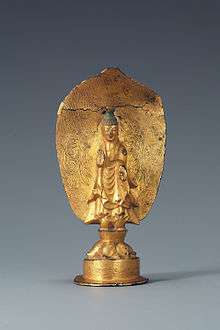
The Abhayamudra "gesture of fearlessness"[7] represents protection, peace, benevolence and the dispelling of fear. In Theravada Buddhism it is usually made while standing with the right arm bent and raised to shoulder height, the palm facing forward, the fingers closed, pointing upright and the left hand resting by the side. In Thailand and Laos, this mudra is associated with the walking Buddha, often shown having both hands making a double abhaya mudra that is uniform.
This mudra was probably used before the onset of Buddhism as a symbol of good intentions proposing friendship when approaching strangers. In Gandharan art, it is seen when showing the action of preaching. It was also used in China during the Wei and Sui eras of the 4th and 7th centuries.
This gesture was used by the Buddha when attacked by an elephant, subduing it as shown in several frescoes and scripts. In Mahayana Buddhism, the northern schools' deities often paired it with another mudra using the other hand.
Bhūmisparśa Mudrā
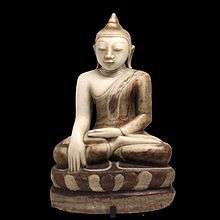
The bhūmisparśa or "earth witness" mudra of Gautama Buddha is one of the most common iconic images of Buddhism. It depicts the Buddha sitting in meditation with his left hand, palm upright, in his lap, and his right hand touching the earth. It represents the Buddha asking Pṛthivi, the devi of the earth, that she witness his enlightenment when he was threatened by demon king Mara.[8]
Bodhyangi Mudrā
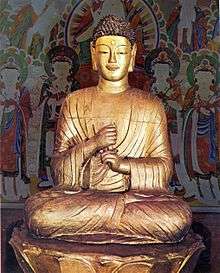
The Bodhyangi mudrā, the "mudrā of the six elements," or the "fist of wisdom,"[9] is a gesture entailing the left-hand index finger being grasped with the right hand. It is commonly seen on statues of the Vairocana Buddha.
Dharmachakra Mudrā
The Buddha preached his first sermon after his Enlightenment in Deer Park in Sarnath. The dharmachakra or "turning of the wheel"[10] mudrā represents that moment. In general, only Gautama Buddha is shown making this mudrā except Maitreya as the dispenser of the Law. Dharmacakra mudrā is two hands close together in front of the chest in vitarka with the right palm forward and the left palm upward, sometimes facing the chest. There are several variants such as in the Ajanta Caves frescoes, where the two hands are separated and the fingers do not touch. In the Indo-Greek style of Gandhara, the clenched fist of the right hand seemingly overlies the fingers joined to the thumb on the left hand. In pictorials of Hōryū-ji in Japan the right hand is superimposed on the left. Certain figures of Amitābha, Japan are seen using this mudra before the 9th century.
Dhyāna Mudrā
The dhyāna mudrā ("meditation mudra") is the gesture of meditation, of the concentration of the Good Law and the sangha. The two hands are placed on the lap, left hand on right with fingers fully stretched (four fingers resting on each other and the thumbs facing upwards towards one another diagonally), palms facing upwards; in this manner, the hands and fingers form the shape of a triangle, which is symbolic of the spiritual fire or the Three Jewels. This mudra is used in representations of Gautama Buddha and Amitābha. Sometimes the dhyāna mudrā is used in certain representations of Bhaiṣajyaguru as the "Medicine Buddha", with a medicine bowl placed on the hands. It originated in India most likely in Gandhāra and in China during the Northern Wei.
It is heavily used in Southeast Asia in Theravada Buddhism; however, the thumbs are placed against the palms. Dhyāna mudrā is also known as "samādhi mudrā" or "yoga mudrā", Chinese: 禅定印; pinyin: [Chán]dìng yìn; Japanese pronunciation: jōin, jōkai jōin.
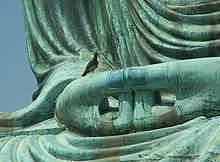
The mida no jōin (弥陀定印) is the Japanese name of a variation of the dhyāna mudra, where the index fingers are brought together with the thumbs. This was predominately used in Japan in an effort to distinguish Amitābha (hence "mida" from Amida) from the Vairocana Buddha,[11] and was rarely used elsewhere.
Varada Mudrā
The Varadamudrā "generosity gesture" signifies offering, welcome, charity, giving, compassion and sincerity. It is nearly always shown made with the left hand by a revered figure devoted to human salvation from greed, anger and delusion. It can be made with the arm crooked and the palm offered slightly turned up or in the case of the arm facing down the palm presented with the fingers upright or slightly bent. The Varada mudrā is rarely seen without another mudra used by the right hand, typically abhaya mudrā. It is often confused with vitarka mudrā, which it closely resembles. In China and Japan during the Northern Wei and Asuka periods, respectively, the fingers are stiff and then gradually begin to loosen as it developed over time, eventually leading to the Tang dynasty standard where the fingers are naturally curved.
In India, varada mudra is used in images of Avalokiteśvara from the Gupta Empire (4th and 5th centuries). Varada mudrā is extensively used in the statues of Southeast Asia.
Vajra Mudrā
The Vajra mudrā "thunder gesture" is the gesture of knowledge.[12] An example of the application of the Vajra mudrā is the seventh technique (out of nine) of the Nine Syllable Seals.
Vitarka Mudrā
The Vitarka mudrā "mudra of discussion" is the gesture of discussion and transmission of Buddhist teaching. It is done by joining the tips of the thumb and the index together, and keeping the other fingers straight very much like the abhaya and varada mudrās but with the thumbs touching the index fingers. This mudra has a great number of variants in Mahayana Buddhism. In Tibetan Buddhism, it is the mystic gesture of Tārās and bodhisattvas with some differences by the deities in Yab-Yum. Vitarka mudrā is also known as Vyākhyāna mudrā ("mudra of explanation").
Gyana Mudrā
The gyāna mudrā ("mudra of wisdom") is done by touching the tips of the thumb and the index together, forming a circle, and the hand is held with the palm inward toward the heart.[13]
Karana Mudrā
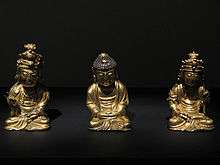
The karana mudrā is the mudra which expels demons and removes obstacles such as sickness or negative thoughts. It is made by raising the index and the little finger, and folding the other fingers. It is nearly the same as the Western "sign of the horns", the difference is that in the Karana mudra the thumb does not hold down the middle and ring finger. This mudra is also known as tarjanī mudrā; Japanese: Funnu-in, Fudō-in.
Martial arts and mudra
Various Asian martial arts forms contain positions identical to these mudras.[14]
Muromoto (2003) in discussing his experience of mudra in relation to his martial arts training makes reference to Mikkyō, Tendai and Shingon Buddhism:
One of the more curious things that I encountered in my martial arts training was the use of mudra in combative arts. Mudra (Japanese: in), for those who aren't familiar with them, are these weird hand gestures that are derived from esoteric Buddhism (mikkyo), particularly the Tendai and Shingon sects. These gestures are supposed to generate spiritual focus and power which then are manifested in some way externally.[15]
Muromoto (2003) states a lineage of mudra in martial arts and evokes Koryū, Ryū, Kantō, Tenshin Shōden Katori Shintō-ryū, Risuke Ōtake and Donn F. Draeger:
In any case, I had known of the use of mudra in koryu ("old" martial arts) since the time I was privy to a discussion with the training master of the Tenshin Shoden Katori Shinto-ryu, Otake Risuke, and the late Donn F. Draeger. Otake sensei described some of the mudra used in his school, which is one of the oldest martial ryu still in existence in Kanto (Eastern) Japan.[15]
In relation to charting a historical tributary to mudra within Japanese fighting culture, Muromoto (2003) incorporates Shintō, Samurai, Tokugawa shogunate, Neo-Confucianism, Zen, the Kamakura shogunate, the Edo period, Takuan Sōhō and Hakuin Ekaku:
The use of mudra and other aspects of mikkyo are found in many instances in many koryu, because mikkyo and Shinto were the religions of the samurai who founded those ryu that were created before the 17th century. Subsequent ryu developed after the imposition of the Tokugawa government were heavily influenced by Neo-Confucianism, and then later by Zen Buddhism. Although Zen was popularized among the warrior class in the Kamakura period, the 14th century, it did not greatly affect martial arts until the latter part of the Edo Period, with the writings of the Zen priests Takuan and Hakuin. And even at that, Edo Period (1600-1868) martial arts were equally influenced by Neo-Confucianism and even, in the latter part, mystical Shinto.[15]
Muromoto (2003) textually maps the execution of the knifehand strike mudrā:
Mikkyo uses mudra most often in combination with various rituals, chants and so on. One common mudra is that of the "knife hand," or shuto. The first two fingers are extended while the thumb and other fingers are clenched. If you look closely, you may see this movement subtly hidden in some koryu kata, especially by old schools such as the Tenshin Shoden Katori Shinto-ryu, or in statues of divine Buddhist beings. This represents the sword of enlightenment, which cuts away all delusions. Sometimes the tips of the extended fingers are grasped in the fist of the other hand. There is a symbolic meaning for this, derived from mikkyo.[15]
See also
Notes
- ↑ Encyclopædia Britannica. (2010). "mudra (symbolic gestures)". Retrieved October 11, 2010.
- ↑ Word mudrā on Monier-William Sanskrit-English on-line dictionary: "N. of partic. positions or intertwinings of the fingers (24 in number, commonly practised in religious worship, and supposed to possess an occult meaning and magical efficacy Daś (Daśakumāra-carita). Sarvad. Kāraṇḍ. RTL. 204 ; 406)"
- ↑ Kongtrul, Jamgön (author); (English translators: Guarisco, Elio; McLeod, Ingrid) (2005). The Treasury of Knowledge (shes bya kun la khyab pa’i mdzod). Book Six, Part Four: Systems of Buddhist Tantra, The Indestructibe Way of Secret Mantra. Bolder, Colorado, USA: Snow Lion Publications. ISBN 1-55939-210-X (alk.paper) p.493
- ↑ Devi, Ragini. Dance dialects of India. Motilal Banarsidass Publ., 1990. ISBN 81-208-0674-3. Pp. 43.
- ↑ Barba 1991, pp. 136
- 1 2 Saraswati, Satyananda (1997). Asana Pranayama Mudrā Bandha. Munger, Bihar India: Bihar Yoga Bharti. p. 422. ISBN 81-86336-04-4.
- ↑ Buswell, Robert Jr., ed. (2013). Princeton Dictionary of Buddhism. Princeton, NJ: Princeton University Press. p. 2. ISBN 9780691157863.
- ↑ Shaw, Miranda Eberle (2006). Buddhist Goddesses of India. Princeton University Press. pp. 17–27. ISBN 978-0-691-12758-3.
- ↑ T.W. Rhys Davids Ph.D. LLD.; Victoria Charles (24 November 2014). 1000 Buddhas of Genius. Parkstone International. p. 515. ISBN 978-1-78310-463-5.
- ↑ explanation of Buddhist Mudras
- ↑ Japanese Architecture and Art Net Users System. "JAANUS / mida-no-jouin 弥陀定印". Retrieved 2 July 2016.
- ↑ written; Beer, illustrated by Robert (2003). The handbook of tibetan buddhist symbols (1st ed.). Chicago (Ill.): Serindia. p. 228. ISBN 978-1932476033.
- ↑ For translation of jñānamudrā as "gesture of knowledge" see: Stutley 2003, p. 60.
- ↑ Johnson 2000, p. 48.
- 1 2 3 4 Muromoto, Wayne (2003) Mudra in the Martial Arts Archived 2007-12-15 at the Wayback Machine.. . Retrieved December 20, 2007.
References
- Barba, Eugenio; Savarese, Nicola (1991). A dictionary of theatre anthropology: the secret art of the performer. London, United Kingdom: Routledge. p. 136. ISBN 0-415-05308-0.
- Draeger, Donn (1980). "Esoteric Buddhism in Japanese Warriorship", in: No. 3. 'Zen and the Japanese Warrior' of the International Hoplological Society Donn F. Draeger Monograph Series. The DFD monographs are transcriptions of lectures presented by Donn Draeger in the late 1970s and early 1980s at the University of Hawaii and at seminars in Malaysia.
- Johnson, Nathan J. (2000), Barefoot Zen: The Shaolin Roots of Kung Fu and Karate, York Beach, USA: Weiser, ISBN 1-57863-142-4
- Stutley, Margaret (2003), The Illustrated Dictionary of Hindu Iconography (First Indian ed.), New Delhi: Munshiram Manoharlal Publishers Pvt. Ltd., ISBN 81-215-1087-2 Originally published 1985, Routledge & Kegan Paul plc, London.
Further reading
- Saunders, Ernest Dale (1985). Mudra: A Study of Symbolic Gestures in Japanese Buddhist Sculpture. Princeton University Press. ISBN 978-0-691-01866-9.
- Hirschi, Gertrud. Mudras: Yoga in Your Hands.
- Taisen Miyata: A study of the ritual mudras in the Shingon tradition: A phenomenological study on the eighteen ways of esoteric recitation in the Koyasan tradition. Publisher s.n.
- Acharya Keshav Dev: Mudras for Healing; Mudra Vigyan: A Way of Life. Acharya Shri Enterprises, 1995. ISBN 9788190095402 .
- Gauri Devi: Esoteric Mudras of Japan. International. Academy of Indian Culture & Aditya Prakashan, 1999. ISBN 9788186471562.
- Lokesh Chandra & Sharada Rani: Mudras in Japan. Vedams Books, 2001. ISBN 9788179360002.
- Emma I. Gonikman: Taoist Healing Gestures. YBK Publishers, Inc., 2003. ISBN 9780970392343.
- Fredrick W. Bunce: Mudras in Buddhist and Hindu Practices: An Iconographic Consideration. DK Printworld, 2005. ISBN 9788124603123.
- A. S. Umar Sharif: Unlocking the Healing Powers in Your Hands: The 18 Mudra System of Qigong. Scholary, Inc, 2006. ISBN 978-0963703637.
- Dhiren Gala: Health at Your Fingertips: Mudra Therapy, a Part of Ayurveda Is Very Effective Yet Costs Nothing. Navneet, 2007. ISBN 9788124603123.
- K. Rangaraja Iyengar: The World of Mudras/Health Related and other Mudras. Sapna Book house, 2007. ISBN 9788128006975.
- Suman K Chiplunkar: Mudras & Health Perspectives: An Indian Approach. Abhijit Prakashana, 2008. ISBN 9788190587440.
- Acharya Keshav Dev: Healing Hands (Science of Yoga Mudras). Acharya Shri Enterprises, 2008. ISBN 9788187949121.
- Cain Carroll and Revital Carroll: Mudras of India: A Comprehensive Guide to the Hand Gestures of Yoga and Indian Dance. Singing Dragon, 2012. ISBN 9781848190849.
- Joseph and Lilian Le Page: Mudras for Healing and Transformation. Integratieve Yoga Therapy, 2013. ISBN 978-0-9744303-4-8.
- Toki, Hôryû; Kawamura, Seiichi, tr. (1899). "Si-do-in-dzou; gestes de l'officiant dans les cérémonies mystiques des sectes Tendaï et Singon", Paris, E. Leroux.
External links
| Wikimedia Commons has media related to Mudras. |
| Look up mudra in Wiktionary, the free dictionary. |